 |
|||||||||




 |
|||||||||




• The program engages practitioners to enhance teaching and learning.

BOSTON, March 6, 2021 — Harvard Business School (HBS) has announced the spring cohort of Executive Fellows for the 2020-21 academic year. The Executive Fellows Program leverages the expertise of outstanding practitioners, including alumni. They all partner with an HBS faculty member to bring their business experience into the MBA program and the School.
The fellows contribute to the School by working with faculty and MBA students on curricular and co-curricular activities, including co-teaching course sessions in the elective curriculum, offering career counseling and development coaching, co-leading Short Intensive Programs, and delivering workshop sessions. They also collaborate with faculty on HBS Online and Executive Education and case development and other research projects. Fellow appointments range from a few months to one year.
“Our inaugural cohort of Executive Fellows provided tremendous insights to our students and shared learnings gained through years of extensive business practice,” says Len Schlesinger, chair of the Executive Fellows Program. “This cohort is equally as impressive and committed to contributing to the HBS community and the School’s mission of educating leaders who make a difference in the world.”
The Spring 2021 cohort of Executive Fellows includes:
• Rob Biederman (MBA 2014)
Biederman is the co-founder and chairman of Catalant Technologies. Catalant Technologies enables companies to get from strategy to execution faster. He is also co-author of Reimagining Work: Strategies to Disrupt Talent, Lead Change, and Win with a Flexible Workforce, which lays out a vision and path for a new relationship between global companies and talent.
Biederman is an Executive Fellow in the Entrepreneurial Management unit, co-teaching with Professor Jeffrey Rayport the Scaling Technology Ventures course on funding and accelerating disruptive internet companies’ growth.
• Gerald Chertavian (MBA 1992)
Chertavian serves on the board of advisors for HBS’s Social Enterprise Initiative (SEI) and is a former member of the World Economic Forum’s Youth Unemployment Council.
As an Executive Fellow with HBS’s Social Enterprise Initiative (SEI), Chertavian works with several students and faculty members on various projects.
• Ãlvaro RodrÃguez Arregui (MBA 1995)
Arregui is the co-founder and managing partner of IGNIA. He is the former chairman of the board of Compartamos Banco (Gentera), Latin America’s largest microfinance institution, and formerly served as chairman of the board of ACCION International. Ãlvaro also served as CFO of Vitro; CEO of Farmacias Benavides and CFO of Grupo Elektra. Ãlvaro is a board member of Harvard University’s David Rockefeller Center for Latin American Studies.
As an Executive Fellow, Arregui is working with HBS’s Social Enterprise Initiative (SEI) as a panelist this spring in Financial Inclusion and Systems Change sessions.
• Daniel Kahn and Leo Tsao
Kahn is the chief of the Department of Justice (DOJ), criminal division, fraud section. He graduated cum laude from Harvard Law School.
Tsao is the principal deputy chief of the money laundering and asset recovery section of the criminal division at the Department of Justice.
As Executive Fellows, Kahn and Tsao are working with Professor Eugene Soltes on the MBA Program Elective Curriculum course, Managing Risk and Uncertainty.
• Vladimir Jacimovic (MBA 1992)
Jacimovic is a seasoned investor with over 25 years of venture, private equity, and public investing and operating experience. He is the founder of Continuum Capital Partners, specializing in a crossover investment strategy, targeting both venture investments in startups and public companies’ assets. Since beginning his venture career in 1996, he has invested in and helped build more than 30 technology companies. In addition to serving on many public and private boards, Vladimir served on Microsoft, Lockheed Martin, and McKinsey & Company.
As an Executive Fellow, Jacimovic is working with Professor Karim Lakhani on AI-first businesses’ issues. He will also engage with students and other HBS faculty members on various projects related to digital transformation.
• Dr. Rana el Kaliouby
El Kaliouby’s life work is about humanizing technology before it dehumanizes us. She is a scientist, entrepreneur, author, and AI (Artificial intelligence) thought leader on a mission to bring emotional intelligence to the digital world. She is co-founder and CEO of Affectiva, an MIT Media Lab spinoff credited with creating artificial emotional intelligence, or Emotion AI (Artificial intelligence). Her memoir, Girl Decoded: A Scientist’s Quest to Reclaim Our Humanity by Bringing Emotional Intelligence to Technology, follows her journey, growing up in the Middle East and moving to the US to become an entrepreneur.
As an Executive Fellow, el Kaliouby works with Professor Lakhani on various AI (Artificial intelligence) and analytics projects. She will engage with both MBA and Doctoral students.
Source: Harvard Business School
|GlobalGiants.Com|
— The editor holds a Certificate in Entrepreneurship in Emerging Economies from Harvard Business School.
Edited & Posted by the Editor | 1:40 PM | View the original post


Photo: The University of Toronto, Rotman School of Management. Toronto, Ontario, Canada. Image Credit: Corey Seeman.
LONDON, March 4, 2021— QS Quacquarelli Symonds, an international higher education think-tank, today released the eleventh edition of the QS World University Rankings by Subject. It is an extensive independent comparative analysis on the performance of 13,883 individual university programs taken by students at 1440 universities in 85 locations across the world, across 51 academic disciplines. They are part of the annual QS World University Rankings portfolio.
• Global Highlights
Harvard University and Massachusetts Institute of Technology are the strongest-performing institutions across the exercise, ranking number-one in twelve subjects.
The United Kingdom’s higher education sector remains resilient. 13 of the 51 subject tables are topped by a British university, with the University of Oxford leading five of those 13.
Chinese higher education continues to reach new heights, with the sector attaining a record number of programs now achieving a top-50 rank.
No university has a larger number of top-50 departments than Canada’s University of Toronto (46).
Switzerland’s ETH Zurich is continental Europe’s top university, achieving number-one spots for Geology, Geophysics, and Earth & Marine Sciences. Based on its share of top-10 ranks, Switzerland is the world’s third-best higher education sector.
Australia now possesses its lowest number of programs ranking among the top 10 globally in the last three years. Its total of 13 top-10 departments is fewer than in 2020 (17) and 2019 (18). Two-thirds of Australian National University’s programs have fallen year-on-year.
Backed by substantial endowments, two Singaporean universities hold number-one positions: Nanyang Technological University is #1 for Materials Science. In contrast, the National University of Singapore - Asia’s best-performing university - is #1 for Petroleum Engineering.
Conversely, Japanese higher education is in relative decline after decades of underfunding for research and Ph.D. students.
India’s Institutes of Eminence program struggles to yield results, with no increase in top-100 representation for India’s public Institutes of Eminence.
Russian higher education continues to move from strength to strength, with a record number of departments achieving top-20 places.
Driven by world-class performances in Dentistry, Petroleum Engineering, and Mining Engineering, Universidade de São Paulo (USP) has retained its status as Latin America’s best-performing university in this exercise.
The University of Cape Town remains Africa’s most competitive institution, with 24 of its programs placing among the top-200.
Jack Moran, the QS Spokesperson, said: “Observing performance trends across nearly 14,000 university departments enables us to draw some conclusions about the commonalities between nations that are improving and nations that are not. Three factors stand out. First, both in terms of faculty body and research relationships, an international outlook correlates strongly with improved performance. Second, rising universities have received strong targeted investment from governments over a decade or more - particularly in China, Russia, and Singapore. Third, improving relationships with industry is correlated with better employment, research, and innovation outcomes.”
Meanwhile, India’s Education Minister, Ramesh Pokhriyal Nishank, addressed at the unveiling of QS World University Rankings by Subject 2021. Chairman, UGC, Prof Dhirendra P Singh; Chairman, NAAC, Dr. Virendar S Chauhan; Vice President, QS Rankings, Mr. Ben Sowter; and Head of Evaluation, QS Rankings, Leigh Kamolins were also virtually present.
12 Indian institutions have made it to the top 100 of the world - IIT Bombay, IIT Delhi, IIT Madras, IIT Kharagpur, IISC Bangalore, IIT Guwahati, IIM Bangalore, IIM Ahmedabad, JNU, Anna University, University of Delhi, and O.P Jindal University.
IIT Madras has been ranked 30th globally for Petroleum Engineering, IIT Bombay is 41st, and IIT Kharagpur is 44th for Minerals and Mining Engineering. The University of Delhi has been ranked 50th in the world for Development Studies.
Sources: QS Quacquarelli Symonds; Ministry of Education, India.
|GlobalGiants.Com|
Edited & Posted by the Editor | 1:52 AM | View the original post
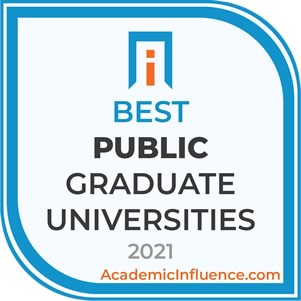
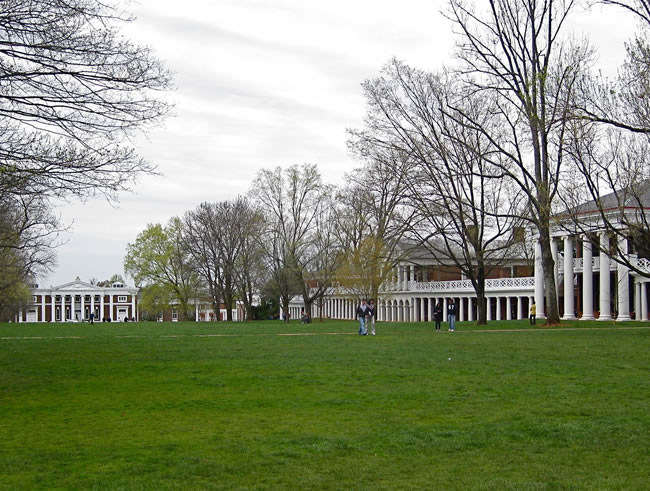
Photo: Lawn at the University of Virginia. Charlottesville, Virginia. Image Credit: Smilla.
FORT WORTH, Texas, Feb. 23, 2021 — Job candidates today find that elite companies expect more of their hires, often requiring a master’s degree just to get considered for a job. Career-minded people who want to stay competitive for the most desirable jobs — and for whom cost and proximity are critical considerations — are increasingly looking to public colleges or universities for their graduate degrees.
But which public graduate schools are best? AcademicInfluence.com has ranked the 50 best public graduate schools in the USA.
It has identified 302 public colleges and universities that meet its criteria. To be included in this list of best graduate schools, a university needs to satisfy the following four conditions:
• 100 Best (Influential) Public Grad Schools of 2021
“Many students and working adults are seeking advanced degree programs that balance excellence with affordability. Often, a public grad school is the wisest choice,” says Dr. Jed Macosko, academic director of AcademicInfluence.com and professor of physics at Wake Forest University.
While some graduate programs offer tuition remission and stipends to students, many do not, especially in business, law, and medicine. Public universities still retain an advantage over private universities when the cost is an issue.
“But don’t let financial factors obscure the true value of a public grad school degree; alumni and faculty at the top-ranked public grad schools have had a major influence in a diverse spectrum of fields,” adds Macosko. “Students attending these schools receive a superior education and earn the credentials to make their impact on the world.”
Source: AcademicInfluence.com
|GlobalGiants.Com|
Edited & Posted by the Editor | 11:48 PM | View the original post

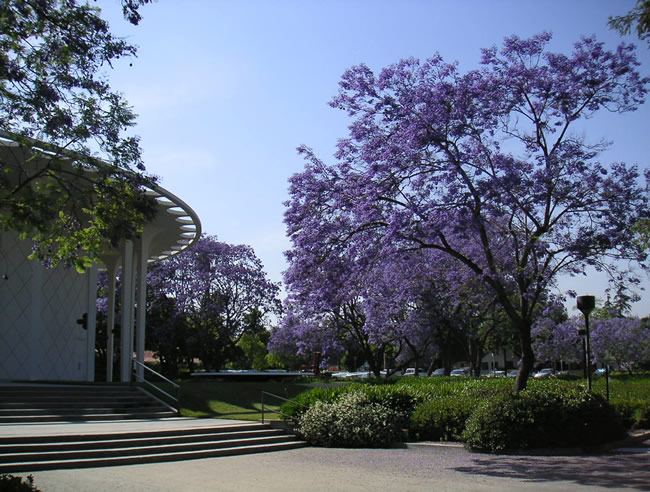
Photo: California Institute of Technology Campus. Pasadena, CA. Image Credit: Michael Adams.
FORT WORTH, Texas, February 20, 2021 — Prospective college students face a tough decision: choose to attend a private college or a public one. The advantages of private colleges and universities include smaller student-to-teacher ratios, student-centered communities, and more intimate settings. But which private college to pick?
To address the needs of the more than 400,000 incoming private college students each fall, AcademicInfluence.com releases its ranking of the leading American private higher education institutions:
“Our ranking of private colleges and universities not only includes some of the most desirable schools in the country, but it also accounts for their influence worldwide,” says Dr. Jed Macosko, academic director of AcademicInfluence.com and professor of physics at Wake Forest University. “The schools featured in our ranking system stand out due to their influential faculty and alumni, and for their many unmatched accomplishments in academics.”
According to the National Center for Educational Statistics, the average annual cost at private universities is nearly $43,000, compared to $20,000 at four-year public universities. However, about one in five students chooses a private, non-profit higher education over the public option.
“Many students prefer the smaller communities and specialized studies that private schools offer compared to their larger public counterparts, and they are willing to pay for that privilege,” adds Macosko.
Private colleges are independent, non-profit schools that receive their funding through endowment income and student tuition fees rather than public tax dollars. If you’re weighing the pros and cons of private vs. public college, consider that private colleges are often smaller, offering more individualized experiences, including opportunities for dynamic classroom discussions, independent research, and one-on-one relationships with your instructors.
AcademicInfluence.com said it had identified 755 private universities in the United States. This list is composed entirely of private universities and colleges that offer four-year undergraduate degrees. To be included in that list of the best private colleges and universities, a school needs to satisfy the following three conditions:
• 50 Best Private Colleges and Universities of 2021
How does AcademicInfluence.com determine the best private colleges & universities?
“The people affiliated with a school are ultimately what make it great. It is why, at the undergraduate level, we rank the best colleges and universities based on what we call Concentrated Influence. Concentrated influence takes the combined influence score of a college or university’s top academic influencers (including faculty and alums) and divides it by the school’s total number of undergraduates.”
“Using concentrated influence allows small and mid-sized schools to shine by taking away the size advantage of larger universities. A small school with proportionately more influential faculty than a large school, whose influence in absolute terms may be bigger, will score higher in a concentrated influence ranking. Our approach highlights undergraduate schools that truly rank for excellence, regardless of size,” AcademicInfluence.com explained.
Suppose you are serious about finding the best colleges and universities for a bachelor’s degree. In that case, you should be asking where the most influential professors are teaching and whether their graduates are themselves advancing the school’s reputation for academic excellence.
“Most ranking sites rely on an opaque combination of reputation surveys and arbitrary performance metrics. Concentrated influence provides a ranking that is free from bias, insulated from manipulation, and reflective of real-world educational outcomes,” AcademicInfluence.com elaborated.
Source: AcademicInfluence.com
|GlobalGiants.Com|
Edited & Posted by the Editor | 10:55 PM | View the original post

Photo: This high-resolution still image is part of a video taken by several cameras as NASA’s Perseverance rover touched down on Mars on Feb. 18, 2021. A camera aboard the descent stage captured this shot. A key objective for Perseverance’s mission on Mars is astrobiology, including the search for signs of ancient microbial life. The rover will characterize the planet’s geology and past climate, paving the way for human exploration of the Red Planet and be the first mission to collect and cache Martian rock and regolith (broken gravel and dust). (Credit: NASA/JPL-Caltech).
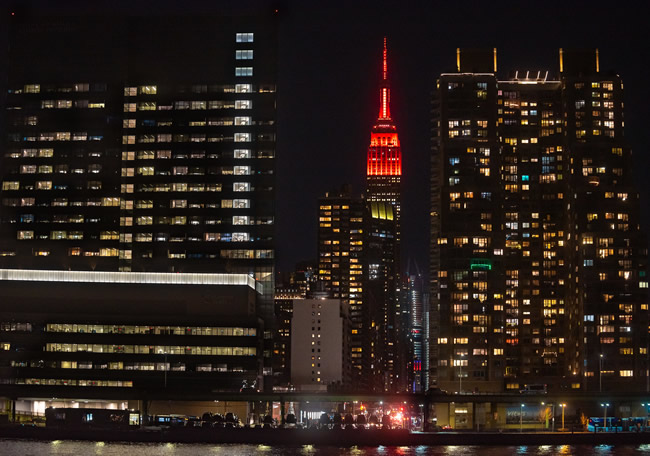
Photo: The Empire State Building is illuminated in red to celebrate this Thursday’s scheduled landing on Mars of NASA’s Perseverance rover, Tuesday, Feb. 16, 2021, in New York City. A key objective for Perseverance’s mission on Mars is astrobiology, including the search for signs of ancient microbial life. The rover will characterize the planet’s geology and past climate, paving the way for human exploration of the Red Planet and be the first mission to collect and cache Martian rock and regolith. Photo Credit: (NASA/Emma Howells).

Photo: NASA Mars Perseverance Live at One Times Square. The live NASA TV broadcast from inside the Mission Support Area of NASA’s Jet Propulsion Laboratory is seen on the One Times Square video board as NASA’s Perseverance rover completes its descent towards the surface of Mars, Thursday, Feb. 18, 2021, in New York City. A key objective for Perseverance’s mission on Mars is astrobiology, including the search for signs of ancient microbial life. The rover will characterize the planet’s geology and past climate, paving the way for human exploration of the Red Planet and be the first mission to collect and cache Martian rock and regolith. Photo Credit: (NASA/Emma Howells).
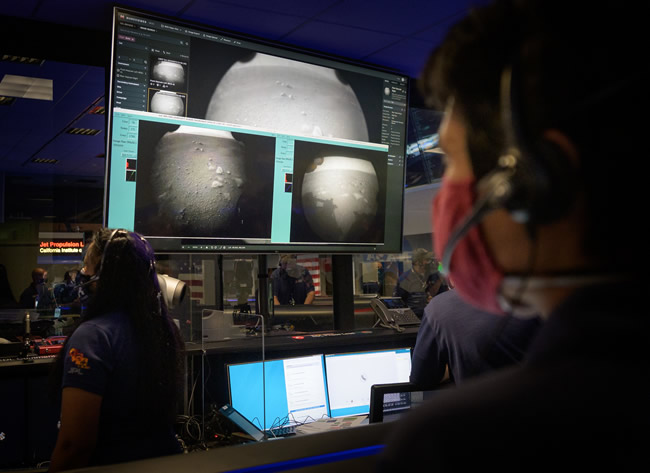
Photo: Members of NASA’s Perseverance Mars rover team watch in mission control as the first images arrive moments after the spacecraft successfully touched down on Mars, Thursday, Feb. 18, 2021, at NASA’s Jet Propulsion Laboratory in Pasadena, California. A key objective for Perseverance’s mission on Mars is astrobiology, including the search for signs of ancient microbial life. The rover will characterize the planet’s geology and past climate, paving the way for human exploration of the Red Planet and be the first mission to collect and cache Martian rock and regolith. Photo Credit: (NASA/Bill Ingalls).
WASHINGTON, Feb. 18, 2021 — The largest, most advanced rover NASA has sent to another world touched down on Mars Thursday, after a 203-day journey traversing 293 million miles (472 million kilometers). Confirmation of the successful touchdown was announced in mission control at NASA’s Jet Propulsion Laboratory in Southern California at 3:55 p.m. EST (12:55 p.m. PST).
The Mars 2020 mission launched July 30, 2020, from Cape Canaveral Space Force Station in Florida. The Perseverance rover mission marks an ambitious first step to collect Mars samples and return them to Earth.
“This landing is one of those pivotal moments for NASA, the United States, and space exploration globally - when we know we are on the cusp of discovery and sharpening our pencils, so to speak, to rewrite the textbooks,” said acting NASA Administrator Steve Jurczyk. “The Mars 2020 Perseverance mission embodies our nation’s spirit of persevering even in the most challenging of situations, inspiring and advancing science and exploration. The mission itself personifies the human ideal of persevering toward the future and will help us prepare for human exploration of the Red Planet in the 2030s.”
About the size of a car, the 2,263-pound (1,026-kilogram) robotic geologist and astrobiologist will undergo several weeks of testing before it begins its two-year science investigation of Mars’ Jezero Crater. While the rover will investigate Jezero’s ancient lakebed and river delta’s rock and sediment to characterize the region’s geology and past climate, a fundamental part of its mission is astrobiology, including the search for signs of ancient microbial life.
“Because of today’s exciting events, the first pristine samples from carefully documented locations on another planet are another step closer to being returned to Earth,” said Thomas Zurbuchen, associate administrator for science at NASA. “Perseverance is the first step in bringing back rock and regolith from Mars. We don’t know what these pristine samples from Mars will tell us. But what they could tell us is monumental - including that life might have once existed beyond Earth.”
Some 28 miles (45 kilometers) wide, Jezero Crater sits on the western edge of Isidis Planitia, a giant impact basin just north of the Martian equator. Scientists have determined that 3.5 billion years ago, the crater had its river delta filled with water.
The power system that provides electricity and heat for Perseverance through its exploration of Jezero Crater is a Multi-Mission Radioisotope Thermoelectric Generator or MMRTG. The U.S. Department of Energy (DOE) provided it to NASA through an ongoing partnership to develop power systems for civil space applications.
“Perseverance is the most sophisticated robotic geologist ever made, but verifying that microscopic life once existed carries an enormous burden of proof,” said Lori Glaze, director of NASA’s Planetary Science Division. “While we’ll learn a lot with the great instruments we have aboard the rover, it may very well require the far more capable laboratories and instruments back here on Earth to tell us whether our samples carry evidence that Mars once harbored life.”
• Paving the Way for Human Missions
“Landing on Mars is always a challenging task, and we are proud to continue building on our past success,” said JPL Director Michael Watkins. “But, while Perseverance advances that success, this rover is also blazing its path and daring new challenges in the surface mission. We built the rover to land and find and collect the best scientific samples for return to Earth. Its incredibly complex sampling system and autonomy not only enable that mission, but they also set the stage for future robotic and crewed missions.”
The Mars Entry, Descent, and Landing Instrumentation 2 (MEDLI2) sensor suite collected data about Mars’ atmosphere during entry, and the Terrain-Relative Navigation system autonomously guided the spacecraft during the final descent. The data from both would help future human missions land on other worlds more safely and with larger payloads.
On the surface of Mars, Perseverance’s science instruments will have an opportunity to shine scientifically. Mastcam-Z is a pair of zoomable science cameras on Perseverance’s remote sensing mast, or head, that creates high-resolution, color 3D panoramas of the Martian landscape. Also located on the mast, the SuperCam uses a pulsed laser to study the chemistry of rocks and sediment and has its microphone to help scientists better understand the stones’ properties, including their hardness.
The rover chassis is home to three science instruments, as well. The Radar Imager for Mars’ Subsurface Experiment (RIMFAX) is the first ground-penetrating Radar on the surface of Mars.
Currently attached to Perseverance’s belly, the diminutive Ingenuity Mars Helicopter is a technology demonstration that will attempt the first powered, controlled flight on another planet.
Project engineers and scientists will now put Perseverance through its paces, testing every instrument, subsystem, and subroutine over the next month or two. Only then will they deploy the helicopter to the surface for the flight test phase. If successful, Ingenuity could add an aerial dimension to exploring the Red Planet in which such helicopters serve as scouts or make deliveries for future astronauts away from their base.
Once Ingenuity’s test flights are complete, the rover’s search for evidence of ancient microbial life will begin in earnest.
“Perseverance is more than a rover, and more than this amazing collection of men and women that built it and got us here,” said John McNamee, project manager of the Mars 2020 Perseverance rover mission at JPL. “It is even more than the 10.9 million people who signed up to be part of our mission. This mission is about what humans can achieve when they persevere. We made it this far. Now, watch us go.”
• More About the Mission
A primary objective for Perseverance’s mission on Mars is astrobiology research, including searching for signs of ancient microbial life. The rover will characterize the planet’s geology and past climate and be the first mission to collect and cache Martian rock and regolith, paving the way for human exploration of the Red Planet.
JPL, a Caltech (California Institute of Technology) division in Pasadena, California, manages the Mars 2020 Perseverance mission and the Ingenuity Mars Helicopter technology demonstration for NASA.
Source: NASA
|GlobalGiants.Com|
Miss my landing? Catch the highlights below.
— NASA's Perseverance Mars Rover (@NASAPersevere) February 19, 2021
Send us your own highlights too. Share your pictures and video using #CountdownToMars. pic.twitter.com/OL2wSAi36e
Edited & Posted by the Editor | 3:29 AM | View the original post
• Oxford/AstraZeneca-developed vaccines to reach countries in the coming weeks.
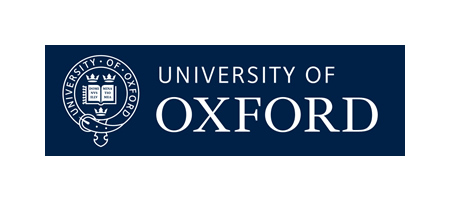
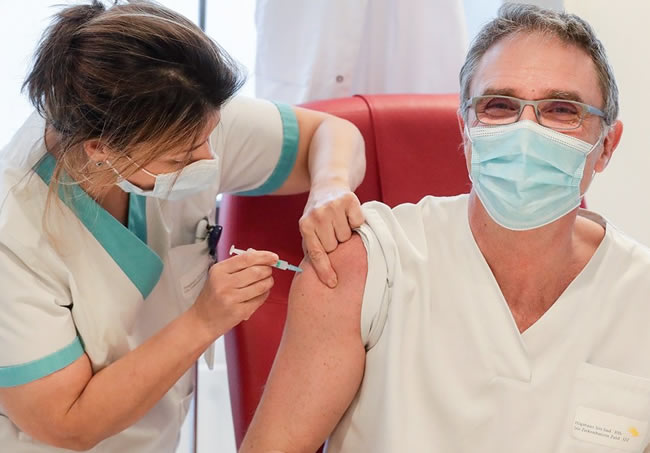
Photo: World Health Organization experts guide the use of the Oxford vaccine. Image credit: WHO / Oxford University.
Geneva, February 15, 2021 - The World Health Organization (WHO) today listed two versions of the AstraZeneca/Oxford COVID-19 vaccine for emergency use, giving the green light for these vaccines to be rolled out globally through COVAX. AstraZeneca-SKBio (Republic of Korea) and the Serum Institute of India produce these vaccines.
WHO’s Emergency Use Listing (EUL) assesses the quality, safety, and efficacy of COVID-19 vaccines and is a prerequisite for COVAX Facility vaccine supply. It also allows countries to expedite their regulatory approval to import and administer COVID-19 vaccines.
“Countries with no access to vaccines to date will finally be able to start vaccinating their health workers and populations at risk. It would contribute to the COVAX Facility’s goal of equitable vaccine distribution,” said Dr. Mariangela Simao, WHO Assistant-Director General for Access to Medicines and Health Products.
But we must keep up the pressure to meet the needs of priority populations everywhere and facilitate global access. To do that, we need two things - a scale-up of manufacturing capacity and developers’ early submission of their vaccines for WHO review.”
The authorization of the Chadox1-nCoV19 vaccine manufactured by AstraZeneca, and the Serum Institute of India (SII), enables global access to the vaccine during the pandemic.
Andrew Pollard, Professor of Paediatric Infection and Immunity, and Chief Investigator on the Oxford vaccine trial said:
‘At the University of Oxford, we are all so pleased by today’s announcement because the emergency use listing from WHO is a critical piece in the path to global access to the Chadox1-nCoV19 vaccine and our mission for vaccines to protect the vulnerable, whoever they are, and wherever they live.’
Today, 2 versions of the AstraZeneca/Oxford #COVID19 vaccine are listed for emergency use, giving the green light for these vaccines to be rolled out globally through #COVAX. The vaccines are produced by AstraZeneca-SKBio 🇰🇷 & the Serum Institute of 🇮🇳
— World Health Organization (WHO) (@WHO) February 15, 2021
👉https://t.co/5NHRcpGxhi pic.twitter.com/BvWM1mrH1S
• World Health Organization experts issue Guidelines on the use of the Oxford Vaccine.
World Health Organization (WHO) Strategic Advisory Group of Experts (SAGE) considers the Oxford coronavirus vaccine safe.
The World Health Organization (WHO) Strategic Advisory Group of Experts (SAGE) produced guidelines for the emergency use of the (ChAdOx1 nCoV-19) coronavirus vaccine developed by the University of Oxford with its partner AstraZeneca.
The WHO has recommended administering two standard doses of the Oxford Vaccine at an 8 to 12-week interval in people aged 18 years and older. Clinical trials have shown that this dosing regimen is safe and effective in preventing symptomatic COVID-19, with no severe cases and no hospitalizations from COVID-19 more than 14 days after the second dose.
The new guidance marks a crucial step towards the Oxford University and AstraZeneca’s goal of providing global access to the vaccine, made available on a not-for-profit basis during the pandemic. This vaccine can be easily transported and stored at domestic fridge temperature (2-8 degrees C). It can be efficiently administered in existing healthcare settings, allowing its rapid deployment worldwide.
Andrew Pollard, Professor of Paediatric Infection and Immunity and Chief Investigator on the Oxford vaccine trial, said: ‘The new guidance from WHO is an important milestone in extending access to the Oxford-AZ vaccine to all corners of the world. The guidance issued after rigorous scrutiny by the WHO Strategic Advisory Group of Experts provides further endorsement that this vaccine can help protect populations from the coronavirus pandemic.’
Sarah Gilbert, Professor of Vaccinology and an Investigator on the Oxford vaccine trial, said: ‘It is excellent news that the WHO has recommended using the SARS CoV-2 vaccine first produced in Oxford. This decision paves the way to the more widespread use of the vaccine to protect people against COVID-19 and gain control of the pandemic.’
• The WHO Strategic Advisory Group of Experts on Immunization (SAGE) has issued interim recommendations for using the Oxford/AstraZeneca COVID-19 vaccine (AZD1222).
• Who should be vaccinated first?
While vaccine supplies are limited, it is recommended that priority be given to health workers at high risk of exposure.
Countries can refer to the WHO Prioritization Roadmap and the WHO Values Framework as guidance for prioritizing target groups.
• Who else can take the vaccine?
Vaccination is recommended for persons with comorbidities that have been identified as increasing the risk of severe COVID-19.
Vaccination can be offered to people who have had COVID-19 in the past. But individuals may wish to defer their COVID-19 immunization for up to six months from the time of SARS-CoV-2 infection to allow others who may need the vaccine more urgently to go first.
• Who is the vaccine not recommended for?
People with a history of a severe allergic reaction to any vaccine component should not take it.
The vaccine is not recommended for persons younger than 18 years of age, pending further studies.
• What’s the recommended dosage?
The recommended dosage is two doses given intramuscularly (0.5ml each) with an interval of 8 to 12 weeks.
Additional research is needed to understand potential longer-term protection after a single dose.
• Is it safe?
While this vaccine has yet to be recommended for an Emergency Use Listing by WHO, it has undergone review by the European Medicines Agency (EMA). Consequently, it meets WHO’s criteria for SAGE consideration.
The EMA has thoroughly assessed the data on the quality, safety, and efficacy of the vaccine and has recommended granting conditional marketing authorization for people aged 18 and above.
The Global Advisory Committee on Vaccine Safety is a group of experts that provides an independent and authoritative guide to the WHO on safe vaccine use. It receives and assesses reports of suspected safety events of potentially global impact.
• How efficacious is the vaccine?
The AZD1222 vaccine against COVID-19 has an efficacy of 63.09% against symptomatic SARS-CoV-2 infection.
Longer dose intervals within the 8 to 12 weeks range are associated with greater vaccine efficacy.
• Does it work against new variants?
SAGE has reviewed all available data on the vaccine’s performance in the settings of variants of concern. SAGE currently recommends the use of the AZD1222 vaccine according to the WHO Prioritization Roadmap, even if virus variants are present in a country. Countries should assess the risks and benefits, taking into consideration their epidemiological situation.
• Does it prevent infection and transmission?
No substantive data are available related to the impact of AZD1222 on transmission and viral shedding.
• In the meantime, we must maintain and strengthen public health measures that work: masking, physical distancing, handwashing, respiratory and cough hygiene, avoiding crowds, and ensuring adequate ventilation, the WHO concluded.
Source: University of Oxford / WHO
|GlobalGiants.Com|
— The Editor holds an Oxford Alumni Card.
Edited & Posted by the Editor | 5:39 AM | View the original post
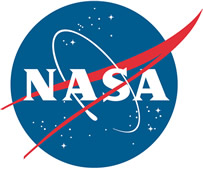


Photo: A United Launch Alliance Atlas V rocket with NASA’s Mars 2020 Perseverance rover onboard launches from Space Launch Complex 41, Thursday, July 30, 2020, at Cape Canaveral Air Force Station in Florida. The Perseverance rover is part of NASA’s Mars Exploration Program, a long-term effort of robotic exploration of the Red Planet. Photo Credit: (NASA/Joel Kowsky).

Photo: A United Launch Alliance Atlas V rocket with NASA’s Mars 2020 Perseverance rover onboard is seen on the launch pad at Space Launch Complex 41, Wednesday, July 29, 2020, Cape Canaveral Air Force Station in Florida. The Perseverance rover is part of NASA’s Mars Exploration Program, a long-term effort of robotic exploration of the Red Planet. Photo Credit: (NASA/Joel Kowsky).

Photo: This illustration depicts NASA’s Perseverance rover operating on the surface of Mars. Perseverance will land at the Red Planet’s Jezero Crater a little after 3:40 pm EST (12:40 pm PST) on Feb. 18, 2021.
WASHINGTON, Feb. 12, 2021 — NASA is inviting the public to participate in virtual activities and events as the agency’s Mars 2020 Perseverance rover nears entry, descent, and landing on the Red Planet, with touchdown scheduled for approximately 3:55 pm EST Thursday, Feb. 18.
Live coverage and landing commentary from NASA’s Jet Propulsion Laboratory in Southern California will begin at 2:15 pm on the NASA TV Public Channel and the agency’s website and the NASA App, YouTube, Twitter, Facebook, Linked In, Twitch, Daily Motion, and THETA.TV.
Among the many firsts with this mission is the agency’s first-ever Spanish-language show for a planetary landing. On Thursday, Feb. 18, at 2:30 pm, NASA will air “Juntos perseveramos,” a show that will give viewers an overview of the mission to Mars and highlight the role Hispanic NASA professionals have had in its success.
The rover will plunge through the thin Martian atmosphere at more than 12,000 mph (about 20,000 kph). A parachute and powered descent will slow the rover down to about two mph (3 kph). During what is known as the sky crane maneuver, the descent stage will lower the rover on three cables to land softly on six wheels at Jezero Crater.
Perseverance also is carrying a technology experiment - the Ingenuity Mars Helicopter - that will attempt the first powered, controlled flight on another planet.
“If there’s one thing we know, it’s that landing on Mars is never easy,” said NASA Associate Administrator for Communications Marc Etkind. “But as NASA’s fifth Mars rover, Perseverance has an extraordinary engineering pedigree and mission team. We are excited to invite the entire world to share this exciting event with us!”
NASA offers many ways for the public to participate and stay up to date on landing information, mission highlights, and interaction opportunities.
• Watch and Participate Virtually
Connect with like-minded space enthusiasts, receive a NASA Social badge, ask questions, and participate in other virtual activities by signing up for the Perseverance Rover Virtual NASA Social event.
NASA will also provide a virtual guest experience for public members during landing, with notifications about mission updates, curated mission resources, and a virtual passport stamp available after landing.
Stay connected and let people know you’re following the mission on Twitter, Facebook, and Instagram. Join the conversation, ask questions, and get answers online by using #CountdownToMars.
• Follow and tag these accounts:
At 7 pm EST Tuesday, Feb. 16, a NASA Social live show previewing landing day will stream live via the JPL YouTube, Facebook, and Twitter accounts.
You also can follow every step of entry, descent, and landing with this visualization and get a preview of all the excitement with a new video.
• Opportunities for Students, Teachers, Educators
Design, build and land your spacecraft - just like NASA scientists and engineers do. Join NASA’s Mission to Mars Student Challenge, where classrooms, informal education groups, families, and individuals will be able to participate in landing week question-and-answer sessions with mission experts.
A Mars 2020 STEM toolkit also is available, with stories on the students who named Perseverance and Ingenuity, opportunities to code your own Mars exploration games, and more.
Join scientists from NASA at a briefing of the National Academies Space Studies Board and Aeronautics and Space Engineering Board Wednesday, Feb. 17, at 11:30 am EST. Participants include:
You also can try out a virtual photo booth that allows you to pose next to the Perseverance rover, listen to the differences between sounds on Mars and Earth, and check out other interactive experiences on the mission’s website.
• Send Your Name to Mars, Again!
Perseverance is carrying three dime-sized chips with 11 million names submitted by people all over the world. Anyone who missed the chance to send their name on Perseverance can sign up to send their name on a future Mars mission.
• Lighting Towns Red Around the World
To celebrate Perseverance’s Red Planet landing, the Empire State Building in New York will light its tower red on Tuesday, Feb. 16, starting at sunset until 2 am the following morning. Besides, the Los Angeles International Airport gateway pylons will glow red from sundown on Wednesday, Feb. 17, through sunrise Friday, Feb. 19. Other sites in the United States recognizing the upcoming landing include select buildings along the Chicago skyline, such as the Adler Planetarium. NASA invites cities around the country and world to participate in “lighting the town red.”
Source: NASA
|GlobalGiants.Com|
Edited & Posted by the Editor | 12:05 PM | View the original post
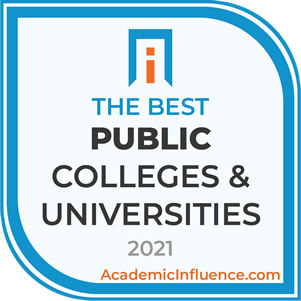
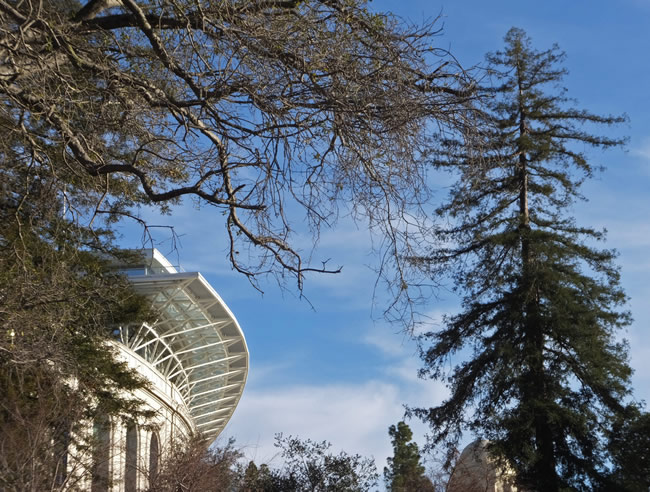
Photo: A redwood tree at the University of California Berkeley Stadium, Berkeley, CA. Image credit: Andrew Aldrich.
FORT WORTH, Texas, Feb. 8, 2021 — What type of school do three out of four prospective undergraduate students ultimately choose? The answer is the public college or university—a perennially popular pick.
To address the needs of the more than three million incoming college students each fall, AcademicInfluence.com releases its ranking of the leading American public higher education institutions: 50 Best Public Colleges and Universities of 2021.
“Public universities and colleges remain popular because of their high value, balancing academic scholarship with reasonable costs,” said Dr. Jed Macosko, academic director of AcademicInfluence.com and professor of physics at Wake Forest University.
This value can be considerable. According to the National Center for Educational Statistics, the average annual cost (tuition, fees, room, and board for full-time, in-state students) at four-year public universities is slightly over $20,000. In contrast, the price to attend a private university averages nearly $43,000 per year.
” However, lower costs and greater accessibility do not mean all public institutions are interchangeable,” adds Macosko. “The schools featured in our ranking stand out, most notably for the global influence of their faculty and alumni and for their excellence in general academics.”
Criteria for the schools in this ranking include:
• The Best Public Colleges and Universities of 2021 — Top 50
Public colleges are schools that receive most of their funding from tax revenues. As a result, the cost of a 4-year degree at a public university is often lower than the price at a private college, especially for students attending a public school in their state.
Public and private colleges and universities operate under different business models — one is a private company with private funding. The state owns the other and receives state and federal funding to operate it. If you’re weighing the pros and cons of private vs. public college, consider that many public colleges provide diverse course offerings, influential professors, and an excellent return on your investment.
Source: AcademicInfluence.com
|GlobalGiants.Com|
Edited & Posted by the Editor | 3:30 PM | View the original post
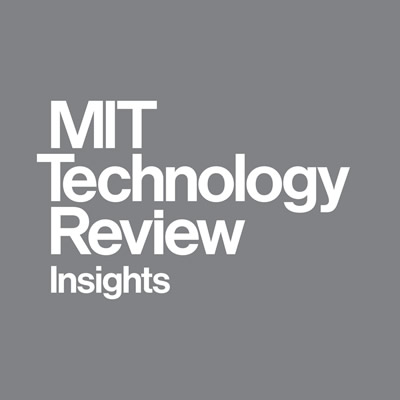

Photo: Greenery. Image credit: Tom Blackwell.
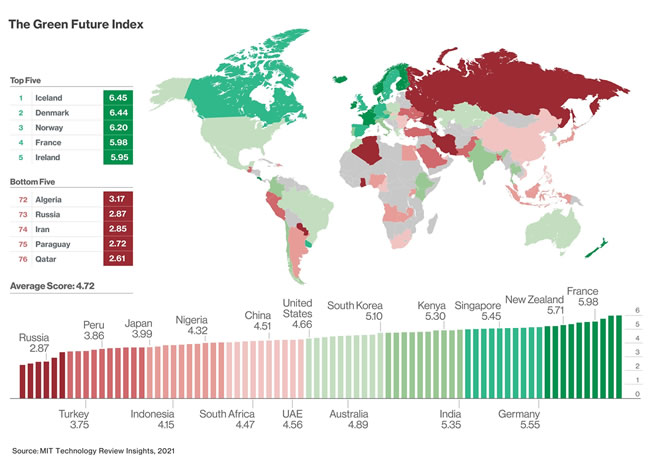
Photo: The MIT Green Future Index Rankings World Map.
CAMBRIDGE, Mass., Jan. 31, 2021 — The Green Future Index, a new study by MIT Technology Review Insights, in association with Citrix, Morgan Stanley, and Salesforce, ranks 76 countries and territories. The nations get ranked on the progress and commitment they are making toward a green future. The index indicates what they are doing to reduce carbon emissions, develop clean energy, innovate in green sectors, and the degree to which governments are implementing effective climate policies.
The MIT Technology Review index shows which countries are progressing fastest in global efforts to decarbonize and limit global heating in line with the Paris Agreement’s goals.
The key findings are as follows:
Europe will be a future green leader. Europe dominates the top of the index, with 15 European nations in the top 20. Many countries across the region have already made progress with curbing emissions, transitioning energy production to renewable sources, and investing in green mobility. Since covid, the EU has committed more than €200 billion in bold green economy investments, accelerating decarbonization even in the most fossil-fuel dependent states.
Iceland, Denmark, and Norway top the index. Iceland, in the first place, aims to be carbon neutral by 2040. The country has become a world leader in clean energy and carbon capture technology. Denmark (2nd) is the largest hydrocarbons producer in Europe to stop issuing new oil and gas exploration licenses. Norway (3rd) is also striving to decouple its economy from fossil fuels.
Costa Rica and New Zealand secure top 10 positions. Costa Rica ranked 7th, and New Zealand, ranked 8th, have made significant strides with renewables and have world-leading agendas for decarbonization across industry and agriculture. Canada (14th), Singapore (16th), and Uruguay (20th), the other non-Europeans in the top 20, have strategies for decarbonization, transitioning energy sources, and government-led initiatives to promote green living. For example, Singapore’s Zero Waste Masterplan aims to reduce landfill waste by 30% between now and 2030.
There is uneven progress across the world’s largest economies. The United States (40th) has reduced emissions over recent years and is responsible for nearly one-fifth of the world’s green patents. Yet, it is emerging from four years of climate denial and remains heavily dependent on fossil fuels and unsustainable farming practices. China (45th) is responsible for more than one-quarter of global emissions but has pledged to become carbon neutral by 2060 and is the world’s fastest-growing renewable energy producer. France (5th), Germany (11th), and Canada (14th) are the highest-ranked countries in the G20.
The countries at the bottom of the index risk losing competitiveness in the green economy. The laggards include South Africa (47th), Vietnam (49th), and Indonesia (57th), where economic pressures run counter to sustainable development. Japan (60th) aims to be carbon neutral by 2050, although government targets for renewable energy remain modest. The 16 “abstainer” countries at the bottom include petrostates such as Saudi Arabia, Iran, Qatar, and Russia. The latter’s Energy Strategy 2035 for expanding oil and gas production identified the trend toward carbon neutrality as an existential threat.
“Covid-19 has created a huge momentum for developing green industries and financing infrastructure that will be clean, technologically advanced, and climate-resilient,” says Nico Crepaldi, head of custom content, MIT Technology Review. “In the future, we’re likely to see ‘green’ being synonymous with economic competitiveness.”
• The Green Future Index Country Rankings
Source: MIT Technology Review Insights
|GlobalGiants.Com|
Edited & Posted by the Editor | 6:49 AM | View the original post
• More than 1200 students have benefited from the International Academic Partnership program of Chandigarh University during the last five years.

Photo: Chandigarh University Campus building.
Chandigarh, India, Jan. 30, 2021 — Chandigarh University has become the first Indian University to have signed Memorandum-of-Understanding (MoUs) with 306 leading Foreign Universities under its International Academic Alliance (IAA) flagship program, the institution announced today. The institution said it is surging ahead with its commitment to impart quality higher education of international standards.
Chandigarh University is a newly established private educational institution located in the Punjab State. It has its campus near Chandigarh, from which it gets its name. And Chandigarh is a city in India, about 250 kilometers north of Delhi and roughly 200 kilometers southeast of Amritsar.
The students & faculty of Chandigarh University now benefit from Global Exposure, Student Exchange, Faculty Exchange, Semester Exchange, and Joint Research Initiatives. They can become members of international student & faculty research groups and present papers at international conferences.
More than 1200 CU students from Engineering, Law, Hotel Management, Journalism, Management, Agriculture, Forensic Sciences, Applied Health Sciences, and Tourism have benefited under the International Academic Partnership program.
While giving details of the IAA flagship program, Chandigarh University’s Pro-Chancellor said, ” Top-ranked universities including QS World ranked universities from the USA, UK, Canada, Australia, European Union, and SAARC have joined hands with Chandigarh University. The international partnerships are a win-win situation both for the academic institutions and students as they share educational, cultural and research resources.” “Students from 40 countries are currently undergoing their higher education in more than 135 Under-Graduate and Post-Graduate programs at Chandigarh University,” he added.
Besides academic learning, the benefit of the International Academic Alliance program, the students also stand a chance to grab global placement opportunities. “World’s top entertainment and hospitality company, Walt Disney has selected 155 students from Hotel Management, Tourism, Finance & Management programs over the last five years,” said the Pro-Chancellor. Foreign universities have also offered scholarships worth Rs. 15 Crores to CU students, which has provided financial assistance to the students who dream of studying abroad.
Satnam Sandhu, Chancellor, Chandigarh University, said, “Students from India have always dreamed of studying abroad or adding some international exposure to their higher education. The International Academic Alliance program of Chandigarh University has helped the students fulfill their dreams. We have recently seen that many Indian students couldn’t travel abroad due to pandemic. It is during such hard times that the global partnership programs of Chandigarh University come in handy for the student community.” Chandigarh University also offers 2+2, 2+1, 1+2 international articulation programs in collaboration with the universities from the USA, UK, Canada, and Australia. Under these programs, the students can start their academic degrees at CU campus and then shift to foreign varsities to complete their degrees using the Credit Transfer Benefit Scheme. “This arrangement helps save money for the students who wish to travel abroad for higher studies during the middle of the academic tenure. The student is allowed to pay the fee as per the Indian arrangement.”
Source: Chandigarh University
|GlobalGiants.Com|
Edited & Posted by the Editor | 6:48 AM | View the original post

Photo: The west facade of ETH Zürich (Swiss Federal Institute of Technology in Zurich) main building, overlooking the city, was designed by German architect Gottfried Semper and completed in 1864. Image credit: Dystopos.
London, January 28, 2021 — Times Higher Education (THE) World’s Most International Universities 2021, published today, reveals which universities have the essential global links, based on their share of international students, staff, and publications, as well as their international reputations. According to THE, its analysis provides more detail on this last metric, showing which national systems have the most substantial global reputations and how this has changed over the past two years. According to THE, prestige is a measure that has become increasingly important for universities.
Prospective students looking to study in the most international environments should apply to universities in Switzerland, Hong Kong, Singapore, or the UK.
Universities, by their nature, are global institutions. Typically, they are home to communities of students and scholars from all over the world, and they tackle some of the globe’s most pressing problems through research.
This table, compiled using the international student score, global staff score, international co-authorship score, and international reputation metrics shows that the above four countries are home to some of the world’s most international universities.
These institutions all have a high proportion of international students and staff, collaborate on research with scholars from across the world, and have a strong global reputation to match.
Research suggests that students’ diverse communities improve the teaching and learning experience, while students’ opportunities to spend time abroad better prepare them to become global citizens.
• Top five most international universities in the world
1. The University of Hong Kong
The University of Hong Kong has embarked on a mission to become “Asia’s global university,” which includes the goal of giving all its undergraduates two opportunities to study outside Hong Kong during their degree by 2022.
Overall, this Hong Kong university has more than 30,000 students, of which more than 35 percent are international.
Teaching at the institution is in English, and education has an international focus to prepare students to become global citizens who could be successful anywhere in the world.
2. ETH Zurich
It is no surprise that Switzerland is home to some of the most international universities globally, given its situation in the heart of Europe, surrounded by France, Italy, Germany, Austria, and Liechtenstein.
ETH Zurich is located in Switzerland’s largest city, Zurich, remarkably safe (although expensive). The primary spoken language is Swiss German, but the university also offers courses in English.
The institution has more than 22,000 students from over 120 countries and is the top university in continental Europe.
The university focuses on teaching and research in STEM subjects. Students and teachers connected to the institution have received 21 Nobel Prizes. One of the most famous alumni is Albert Einstein.
3. The Chinese University of Hong Kong
Students from more than 50 countries study at the Chinese University of Hong Kong.
The university has exchange partnerships with more than 282 institutions in 36 countries and regions. Some 6,000 students study abroad or take part in a learning abroad program or internship.
4. University of Oxford
The University of Oxford is not only the top university in the world, but it also happens to be one of the most international.
Over a third of students at the University of Oxford are international students from 160 countries and territories. International students have been attending the University of Oxford for hundreds of years, with the first international student arriving way back in 1190.
Almost half of the university staff are also international, and the institution has links with many other institutions worldwide.
Prospective international students can listen to the university’s International Students podcast, which talks you through Oxford’s academic and social aspects.
5. Imperial College London
Imperial College London focuses on teaching and learning around science, engineering, medicine, and business.
More than 60 percent of students are international, with undergraduates coming from over 125 countries.
Clubs and support services with an international focus at Imperial College include International Medical Careers and the Indian National Student Association.
• Most international universities in the world 2021
The data in Times Higher Education’s ranking of The World’s Most International Universities 2021 is mainly from the “international outlook” pillar of THE World University Rankings 2021. It considers a university’s proportions of international students, international staff, and journal publications with at least one international co-author. Each of these elements is given equal weighting in calculating the score for this pillar.
• International Reputation
The table adds a fourth component, which makes up 25 percent of the total score: a university’s international reputation. It is a measure of the proportion of votes from outside the home country that the institution achieved in THE’s annual invitation-only Academic Reputation Survey, which asks leading scholars to name the world’s best universities for teaching and research in their field.
Only institutions that received at least 100 votes in the survey were eligible for inclusion.
Metrics and weightings:
25 percent: the proportion of international staff
25 percent: the proportion of international students
25 percent: international co-authorship
25 percent: an international reputation
Source: Times Higher Education
|GlobalGiants.Com|
Edited & Posted by the Editor | 2:54 PM | View the original post
• The latest edition includes new rankings of business and psychology bachelor’s programs.


Photo: The Ohio State University, Columbus, OH, West Campus. Image Credit: Dan Keck.
WASHINGTON, Jan. 26, 2021 — U.S. News & World Report, a leading global authority in education rankings, today published the 2021 Best U.S. Online Programs rankings. The rankings evaluate more than 1,600 online bachelor’s and master’s degree programs in the USA. They assist learners looking to complete or further their education. These programs offer an alternative option for prospective students looking to fulfill their academic goals while pandemic restrictions remain in much of the country.
The Best Online Programs rankings only include programs administered online. In other words, they do not evaluate schools or programs that are temporarily virtual due to the coronavirus pandemic.
Embry-Riddle Aeronautical University moves back up to No. 1 this year among Best Online Bachelor’s Programs. For MBAs, Carnegie Mellon University ties with the University of North Carolina-Chapel Hill for the top spot. Columbia University has the top-ranked computer information technology master’s program. Tied for No. 1 among Best Online Master’s in Nursing programs are Rush University and the University of South Carolina. Top education and engineering master’s programs are at the University of Florida and Columbia University, respectively.
For the first time, U.S. News published specialty rankings of bachelor’s programs in business and psychology. These complement the master’s level specialty rankings across 18 subject areas such as finance MBA and nursing administration/leadership.
“As in-person gatherings remain limited, we might see more interest in online degrees than in pre-pandemic years,” said Anita Narayan, managing editor of Education at U.S. News. “But online degrees aren’t only practical in the short term - distance education can also be conducive to a schedule that includes full-time work or other commitments.”
U.S. News said it remains the only publication to comprehensively evaluate online degrees at the program level rather than the school level. The rankings assess student services and technology, faculty credentials, and student engagement, using data collected directly from each institution. The report considered only degree-granting programs offered primarily online by regionally accredited institutions. The programs that score the highest are those applying educational best practices specific for distance learners.
• 2021 U.S. News & World Report Best Online Programs
• Bachelor’s Programs (Top Ten)
• Master’s Programs
• MBA (Top Ten)
• Business, non-MBA
• Computer Information Technology
• Criminal Justice/Criminology
• Education
• Engineering
• Nursing
On Friday, Jan. 29, U.S. News will host a free webinar on the potential benefits of enrolling in an online bachelor’s program, as well as what differentiates these programs from temporary virtual learning.
U.S. News & World Report is a global leader in quality rankings that empower people to make better, more informed decisions about important issues affecting their lives. A digital news and information company focused on Education, Health, Money, Travel, Cars, and News, USNews.com provides consumer advice, rankings, and analysis to serve people making complex decisions. Founded in 1933, U.S. News has its headquarters in Washington, D.C.
Source: U.S. News & World Report
|GlobalGiants.Com|
Edited & Posted by the Editor | 6:25 AM | View the original post


• UPDATE.
• January 16, 2021.
Prime Minister Narendra Modi of India launched the pan India rollout of the COVID-19 vaccination drive via video conferencing. It is the world’s most extensive vaccination program covering the entire length and breadth of the country.

Photo: Health care workers celebrate the 1st phase of the pan India rollout of COVID-19 vaccination drive at Dr. Ram Manohar Lohia Hospital, New Delhi, on January 16, 2021.
• January 09, 2021.
• Oxford Vaccine: India starts Vaccination on January 16, 2021, with Priority to Healthcare & Frontline Workers followed by those above 50 Years and Under-50 with Co-morbidities.

Prime Minister Modi reviews the status of COVID-19 and preparedness for COVID19 vaccination.
The vaccination drive would kick off on January 16, 2021, after the forthcoming festivals, including Lohri, Makar Sankranti, Pongal, and Magh Bihu.
Priority will be given to the healthcare workers and the frontline workers, estimated to be around three crores in number.
They would be followed by those above 50 years of age and the Under-50 population groups with Co-morbidities, numbering around 27 crores.
New Delhi, January 09, 2021 — Prime Minister Modi chaired a high-level meeting to review the status of COVID-19 in the country and the preparedness of the State/UTs for COVID vaccination today.
The Prime Minister took a detailed and comprehensive review of COVID management’s status, covering various issues.
The Prime Minister reviewed the center’s preparedness status in close collaboration with the State and UT Governments for the vaccine’s roll-out soon.
According to the India Ministry of Health and Family Welfare, the vaccination exercise comprises the principles of people’s participation (Jan Bhagidari); utilizing the experience of elections (booth strategy) and Universal Immunization Program (UIP); no compromise of existing healthcare services, especially national programs and primary health care; no compromise on scientific and regulatory norms, other SOPs; and an orderly and smooth implementation driven by technology.
The roll-out of the COVID-19 vaccine will prioritize healthcare and frontline workers. They are estimated to be around three crores, followed by those above 50 years of age and the under-50 population groups with co-morbidities, numbering about 27 crores.
The Prime Minister got apprised about the Co-WIN Vaccine Delivery Management System. The unique digital platform will provide real-time information on vaccine stocks, their storage temperature, and individualized tracking of the COVID-19 vaccine beneficiaries. This platform will assist the program managers across all levels through automated session allocation for pre-registered beneficiaries, their verification, and generating a digital certificate upon completing the vaccine schedule.
The vaccinators and vaccine administrators comprise a crucial pillar of the vaccination exercise. Two thousand three hundred sixty participants were trained during the national level Training of Trainers, including state immunization officers, cold chain officers, IEC officials, and development partners. More than 61,000 program managers, 2 lakh vaccinators, and 3.7 lakh other vaccination team members have trained so far as part of training at States, Districts, and Block levels, the Health Ministry elaborated.
After the detailed review, the Government of India decided that because of the forthcoming festivals, including Lohri, Makar Sankranti, Pongal, and Magh Bihu, the COVID19 vaccination will start on January 16, 2021.
• January 03, 2021.
• People of India receive their New Year Gift; Prime Minister Modi congratulates the Nation as Drugs Controller General of India approves the Oxford Vaccine for emergency use; The University of Oxford welcomes Regulatory Authorisations.


Photo: St. Mary’s College, University of Oxford, Oxford. Image Credit: Billy Wilson.
Oxford / New Delhi, January 03, 2021 — The Drugs Controller General of India today approved the Oxford Vaccine for emergency use. Prime Minister Narendra Modi congratulated the nation and called it a decisive turning point to strengthen a spirited fight against Corona. The approval accelerates the road to a healthier and COVID-free country, he added.
India’s Home Minister Amit Shah hailed the approval of the COVID-19 vaccine granted by the Drugs Controller General of India (DGCI) today. He said the permission to ‘Made in India’ vaccines would prove to be a game-changer. It is a momentous achievement for India, he remarked.
The Serum Institute of India, Pune, is the manufacturing partner of the vaccine candidate named Covishield, developed jointly by the University of Oxford’s Jenner Institute and AstraZeneca.
The Serum Institute of India had selected 17 sites in India to conduct the trial. A total of 1,600 candidates took part in the study.
• The University of Oxford welcomes Regulatory Authorisations:
Meanwhile, the University of Oxford has welcomed the news that the UK Government has accepted the recommendation from the Medicines and Healthcare products Regulatory Agency (MHRA) to authorize the emergency use of the coronavirus vaccine in the UK.
Professor Andrew Pollard, Director of the Oxford Vaccine Group and Chief Investigator of the Oxford Vaccine Trial, said:
‘The regulator’s assessment that this is a safe and effective vaccine is a landmark moment, and an endorsement of the huge effort from a devoted international team of researchers and our dedicated trial participants.’
‘Though this is just the beginning, we will start to get ahead of the pandemic, protect health and economies when the vulnerable are vaccinated everywhere, as many as possible, as soon as possible.’
Professor Sarah Gilbert, Professor of Vaccinology at the University of Oxford, said:
‘This is a day for the team developing the vaccine to celebrate, after a year of tough work under difficult circumstances. The first authorization or use of the vaccine outside of clinical trials has been granted. We still have more to do and will continue to provide more data to multiple regulatory authorities until we can see the vaccine being used to save lives around the world.’
The Oxford vaccine is stable, easily manufactured, transported, and stored at domestic fridge temperature (2-8 degrees C). It can be easily administered in existing healthcare settings, allowing its rapid deployment.
Oxford University’s collaboration with AstraZeneca has been crucial to the successful development of the vaccine and vital for its global manufacturing and distribution across the world. AstraZeneca already has international agreements to supply three billion doses of the vaccine, with access through more than 30 supply agreements and partner networks.
A key element of Oxford’s partnership with AstraZeneca is the joint commitment to provide the vaccine on a not-for-profit basis for the duration of the pandemic across the world and in perpetuity to low- and middle-income countries.
Professor Louise Richardson, Vice-Chancellor at the University of Oxford, said:
‘This is a great day for British science and a great day for universities everywhere. Above all, it is a great day for the many people whose lives will be saved by this vaccine. We are greatly indebted to those who have designed, developed, manufactured, and evaluated it.’
Sources: Prime Minister’s Office, New Delhi. The University of Oxford.
|GlobalGiants.Com|
— The editor holds an Oxford Alumni Card and is a member of the ‘Oxford and Cambridge Society of India.’
Edited & Posted by the Editor | 6:03 AM | View the original post
• Chandigarh University is offering academic scholarships worth Rs. Thirty-three crores to deserving students through CUCET 2021.
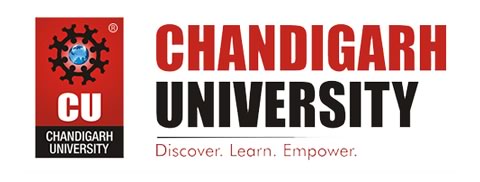
CHANDIGARH, India, Dec. 23, 2020 — “National level Entrance cum Scholarship Test CUCET 2021 announced by Chandigarh university is a novel attempt to search for budding talent from every corner of India. It motivates them to pursue their dream career by offering them an academic scholarship to overcome financial barriers.” It was stated by Union Minister for Education, Dr. Ramesh Pokhriyal, during the launch ceremony of the National Level Entrance cum Scholarship Test of Chandigarh University “CUCET 2021”. The National Entrance cum Scholarship Test would offer academic scholarships worth Rs. 33 Crores to the students in more than 135 Under-Graduate and Postgraduate programs offered by the University; a deserving student based on CUCET-2021 scores can avail scholarships up to 100% in the academic fees.
While delivering his address, the Union Minister for Education, Dr. Pokhriyal, said, “We have often witnessed cases of drop-outs in the Indian Education System where meritorious students have to opt-out of higher education set-up due to financial constraints. CUCET-2021 is an attempt to plug these drop-out cases as it offers a helping hand for such talented students from all across India”. The student can fill an online application form and can appear online with the flexibility to choose his or her date & time slot. Chandigarh University would conduct CUCET-2021 in two phases. The first phase would run from December 2020 to May 2021.
“Chandigarh University is investing heavily in the talent of Indian Youth. It offers a national platform through CUCET-2021 to such deserving students who aspire to be successful by undergoing quality higher education in the field of their choice,” said Satnam Singh Sandhu, Chancellor, Chandigarh University.
Prof. Satbir Singh Sehgal, Registrar of Chandigarh University, while briefing about CUCET-2021, said, “The entrance test would be compulsory for aspiring students who seek admission in Engineering, Pharmacy, MBA, 5 Years Integrated Under-Graduate Law Programs, and Agriculture. The test would also offer academic scholarships for all the 135 UG & PG programs offered by Chandigarh University”. Dr. Sehgal further added that “Students can apply for CUCET-2021 through online and offline mode where the applications are available at University Website and regional centers of University across 21 States & UTs”. The University is offering scholarships in 10 percent of the total seats in every Undergraduate and Postgraduate course. “Ever since the inception of University in 2012, Chandigarh University has offered academic scholarships to more than 63,000 students to promote talent and merit amongst the Indian Youth who dream of getting quality & world-class education,” Dr. Sehgal added.
One of the engineering students who bagged a 75% scholarship through CUCET-2020, Atul Ranjan from Jharkhand, states that “I could fulfill my dream of studying at one of the prestigious institutions of India only because of CUCET Scholarship, as it offered me a financial support.”
Chandigarh University is a NAAC A+ Grade University and an autonomous educational institution near Chandigarh. It is the youngest University in India and the only private University in Punjab to be honored with an A+ Grade by NAAC (National Assessment and Accreditation Council). CU offers more than 109 UG and PG programs in engineering, management, pharmacy, law, architecture, journalism, animation, hotel management, commerce, and other disciplines.
Source: Chandigarh University
|GlobalGiants.Com|
India’s Education Minister, Dr. Ramesh Pokhriyal, launches Chandigarh University’s National Level Entrance Cum Scholarship Test CUCET 2021.
Edited & Posted by the Editor | 8:08 AM | View the original post
• Researchers at Harvard Business School’s Project on Managing the Future of Work and BCG’s Henderson Institute find that 90% of companies surveyed see a future competitive advantage in shifting their talent model to a blend of full-time and freelance employees. With a surge in remote work due to Covid-19, the move to an on-demand workforce would accelerate.

BOSTON — Researchers from Harvard Business School’s Managing the Future of Work Project and Boston Consulting Group’s Henderson Institute today released “Building the On-Demand Workforce.” The report explores the recent rise of digital talent platforms that create a new marketplace for high-skill freelance work. Early adopters of these platforms see a competitive advantage in shifting their workforce model to a blend of full-time and freelance employees. At the same time, millions of highly skilled professionals, who seek flexible and remote work, are using these platforms to connect with employers.
Researchers from BCG, and HBS’ Project on Managing the Future of Work, surveyed nearly 700 senior business leaders at US companies. The survey’s goal was to understand better the pervasiveness and patterns in using new talent platforms. The report is based on information from this groundbreaking survey and in-depth interviews with representatives from the talent platforms themselves and the companies that use them.
“Our research showed that many leadership teams have not yet fully grasped the strategic significance of these talent platforms. They are more than a stopgap. They are a means for resolving the chronic problems companies face while filling their talent needs. Business leaders cannot risk missing a critical opportunity to build a more flexible, resilient organization,” said Joseph Fuller, professor of management practice and a co-chair of the Project on Managing the Future of Work at Harvard Business School.
• Transforming the Workforce Transforms the Work
Due to rapid automation, digital transformation, and demographic change, companies are increasingly struggling to find people with the skills they need when they need them. A growing ecosystem of more than 300 talent platforms has emerged, offering companies on-demand access to highly skilled workers. These high skill platforms — companies like Catalant, InnoCentive, Kaggle, Toptal, and Upwork — can be grouped roughly into three categories: marketplaces for premium talent, digital freelancing marketplaces, and crowdsourcing innovation platforms.
The COVID-19 crisis has underscored the need for companies to be more agile in reacting to changes, managing fixed costs, and managing the work itself, lending even more importance to the fact that users of platforms report increased speed to market, productivity, and ability to innovate.
• Now Is the Time to Get Strategic
The survey shows that an increasing number of managers have been experimenting with these new talent platforms. Still, to bring about change on the scale needed to innovate new business models, the study underlines that companies will have to get strategic and appoint a C-suite leader to explore how talent platforms can unlock new value sources.
“New models should not simply be used to outsource what was previously done in house. Instead, they should prompt companies to fundamentally reconsider what their core business model can look like in a talent-fluid future,” said Allison Bailey, a managing director, and senior partner at BCG.
Harvard Business School’s Project on Managing the Future of Work pursues research that business and policy leaders can put into action to navigate the complex, fast-changing nature of work.
The BCG Henderson Institute is Boston Consulting Group’s strategy think tank, dedicated to exploring and developing valuable new insights from business, technology, and science by embracing the powerful technology of ideas. The Institute engages leaders in provocative discussion and experimentation to expand the business theory and practice boundaries and translate innovative ideas from within and beyond business.
Founded in 1908, Harvard Business School (HBS) is part of Harvard University. The HBS faculty of more than 200 offers full-time programs leading to MBA and doctoral degrees and more than 70 open enrollment Executive Education programs. For more than a century, HBS faculty have drawn on their research, their experience in working with organizations worldwide, and their passion for teaching to educate leaders who make a difference in the world, shaping the practice of business and entrepreneurship around the globe.
Source: Harvard Business School (HBS)
|GlobalGiants.Com|
— The editor holds an HBS certificate.
Edited & Posted by the Editor | 8:04 AM | View the original post
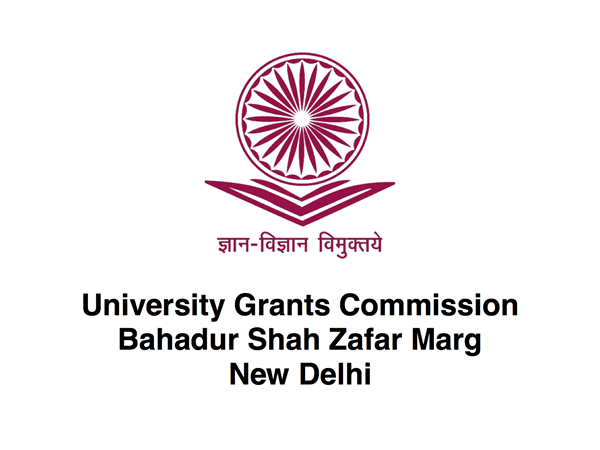
• UNIVERSITY GRANTS COMMISSION (UGC) INDIA NOTIFIES ALL VICE-CHANCELLORS ON COMPLIANCE OF ITS DIRECTIONS REGARDING REFUND OF FEE.
New Delhi, December 18, 2020 — UGC has sent a letter to all vice-chancellors drawing their attention to its “Guidelines on Academic Calendar for the First Year of Under-Graduate and Post-Graduate Students of the Universities for the Session 2020-21 in view of COVID-19 Pandemic.” The guidelines provide that —
” ln order to avoid financial hardship being faced by the parents due to lockdown and related factors, a full refund of fees be made on account of all cancellation of admissions/migration of students, up to 30.11.2020, for this very session as a special case. To be crystal clear — the entire fees, including all charges, be refunded in totality (zero cancellation charges) on cancellation/migration up to 30.11.2020. Thereafter, on cancellation/withdrawal of admissions up to 31.12.2020, the entire fee collected from a student be refunded in full after a deduction of not more than Rs. 1000/- as processing fee.”
“It is reiterated that the UGC guidelines are to be followed mandatorily by all the universities in letter and spirit.”
“Any institution/university found to be violating the guidelines and refusing to refund the fee by giving its own interpretation of the guidelines shall be liable for punitive actions as notified in clause 5 of the UGC notification refund of fees and non-retention of the original certificates.”

• UNIVERSITY GRANTS COMMISSION (UGC) INDIA WILL KEEP OPEN THE APPLICATION SUBMISSION PORTAL FOR HIGHER EDUCATIONAL INSTITUTIONS ENTITLED TO OFFER ONLINE PROGRAMMES TILL DECEMBER 31, 2020.
New Delhi, December 15, 2020 — University Grants Commission (UGC) India announced through a Public Notice that it has decided to keep open the Application Submission Portal for Higher Educational Institutions entitled to offer Online Programmes without prior UGC approval up to December 31, 2020. The decision is per the University Grants Commission (Open and Distance Learning Programmes and Online Programmes) Regulations, 2020.
“ Accordingly, the duly certified hard copy of the application and affidavit in the prescribed format along with annexures shall reach the office of the Joint Secretary (DEB), Distance Education Bureau, University Grants Commission, 35, Feroze Shah Road, Delhi -110001, within ten working days after submission of the online application,” the announcement stated.
UGC has also asked the HEI’s to regularly visit the Submission Portal for the latest updates and further announcements in this regard.
Source: University Grants Commission, India
|GlobalGiants.Com|
Edited & Posted by the Editor | 10:05 AM | View the original post

Photo: UNESCO Director-General Audrey Azoulay speaking at the 15th session of the Intergovernmental Committee of the UNESCO Convention for the Safeguarding of the Intangible Cultural Heritage. December 14, 2020. Image provided by & copyright © UNESCO / Christelle ALIX.
Paris, December 14, 2020 — As countries begin to administer COVID-19 vaccines, UNESCO and Education International, the global federation of education unions, call on governments and the international community to consider teachers and school personnel priority group in vaccination efforts.
“Reopening schools and education institutions safely and keeping them open as long as possible is an imperative,” said UNESCO Director-General Audrey Azoulay and Education International’s General Secretary David Edwards in the joint video message.” In this context, as we see positive developments regarding vaccination, we believe that the governments must consider teachers and education support personnel as a priority group.”
Educational disruptions impacted over 100 million teachers and school personnel due to the COVID-19 crisis around the world. UNESCO’s latest data indicates that schools remain fully closed in 27 countries affecting over 300 million learners. Closures harm students’ learning, safety, and well-being, affecting the most vulnerable students the hardest. It also brings adverse social and economic consequences to societies.
The message, released on the 60th anniversary of the Convention that promotes the right to education, praises teachers for their dedication throughout school closures. “When schools and education institutions closed, teachers and support personnel remained on the frontline. They reinvented the way we teach, the way we learn. They supported their students - too often with no training or adequate tools.”
In the Global Education Meeting convened by UNESCO in October 2020, heads of state and ministers committed to supporting all teachers and education personnel as frontline workers and prioritizing students and educators’ health and safety.
Source: UNESCO
|GlobalGiants.Com|
Teachers and school personnel must be a priority group in COVID-19 vaccination efforts — UNESCO and Education International.
Edited & Posted by the Editor | 2:58 PM | View the original post
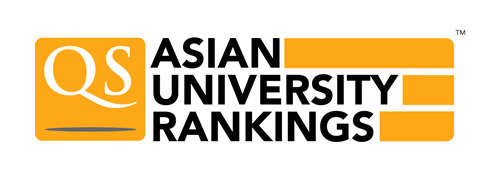
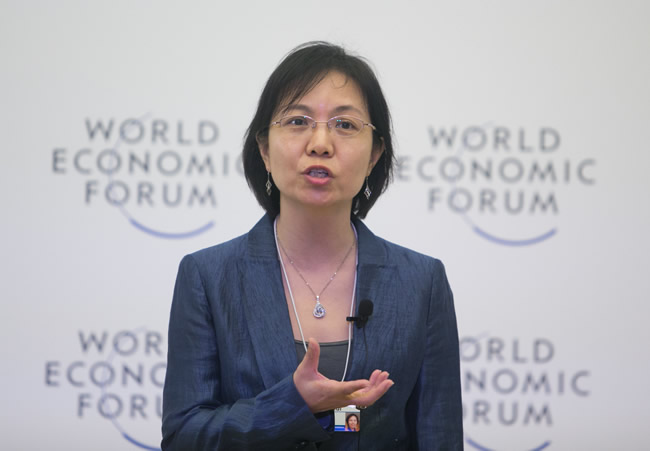
Photo: Ideas Lab with Tsinghua University. Mao Donghui, Head, Tsinghua x-lab, Tsinghua University, People’s Republic of China, at the World Economic Forum - Annual Meeting of the New Champions in Tianjin, People’s Republic of China 2014. Image provided by & copyright © World Economic Forum / Ciaran McCrickard. China’s Tsinghua University is at 2nd place in the QS Asia University Rankings 2021.
LONDON, Nov. 25, 2020 — QS Quacquarelli Symonds, global higher education think-tank and compiler of the world’s most-consulted university rankings portfolio, has today released the latest edition of their annual list of Asia’s best higher education institutions. The National University of Singapore is the continent’s best university for the third consecutive year.
The 2021 QS World University Rankings: Asia compares 650 universities and is QS’s most extensive independent comparison of the Asia region’s higher education system. The table accounts for eleven key indicators of university performance. They reflect:
The 650 featured universities are in 18 locations across Asia. The most-represented area is Mainland China (124 ranked universities). Its closest competitor systems are India (107), Japan (105), South Korea (88), Taiwan (43), Pakistan (40), Malaysia (35), and Indonesia (30).
China’s Tsinghua University rises to 2nd - its highest position in the history of the ranking, while Shanghai Jiao Tong University enters the top ten for the first time.
The University of Hong Kong (HKU) is Hong Kong’s top university but drops one place.
Universiti Malaya breaks into the top ten for the first time, and 24 of Malaysia’s 35 universities have improved their position.
Japan has more universities in the top 50 of the ranking (11) than any other nation, location, or territory.
South Korea’s top university is Korea University (12th).
Six of Asia’s top ten universities for research productivity are Indian. However, Indian research quality does not match quantity, and Indian teaching capacity and employability scores decline.
IIT Bombay (37), IIT Delhi (47), IIT Madras (50), Indian Institute of Science, Bangalore (56), IIT Kharagpur (58), University of Delhi (71), IIT Kanpur (72), and Jawaharlal Nehru University (81) lead the universities from India.
NUST Islamabad (76), Quaid-i-Azam University (106), Lahore University of Management Sciences (121), COMSATS University Islamabad (146), University of Engineering & Technology, Lahore (175), Pakistan Institute of Engineering and Applied Sciences, Islamabad (176), Punjab University, Lahore (178), and University of Peshawar (217) lead the universities from Pakistan.
• QS UNIVERSITY ASIA RANKINGS 2021 — TOP 25
QS RANK — UNIVERSITY — COUNTRY
• INDIAN SUBCONTINENT RANKINGS — TOP 50
S. NO. — QS ASIA RANK — UNIVERSITY — COUNTRY
Ben Sowter, Director of Research at QS, said: “This year’s results reiterate the intensely competitive, intensely dynamic nature of Asian higher education. China’s best universities continue to progress, Japanese higher education is stagnating - and Malaysia remains on the rise.”
Source: QS Quacquarelli Symonds
• Shoolini University tops India in QS Asia Rankings on Citation Index.

SOLAN, India, Nov. 29, 2020 — Eleven-year-old Shoolini University of Biotechnology and Management Sciences, based in Solan, Himachal Pradesh, has topped India in the 2021 QS Asia Rankings for Citation Index, an indicator of quality research in institutions.
“Shoolini University, the youngest to be among the top-ranked, has been placed joint seventh among all private universities in the country and 38th among all universities and educational institutions in India. It includes better performance than several established institutions nearby, such as Panjab University Chandigarh,” Shoolini stated in a Press Announcement.
The QS Asia rankings also placed Shoolini University among the top 300 Universities of Asia.
Shoolini Vice-Chancellor Prof. P. K. Khosla said through the QS rankings, the University has reflected the sincerity and hard work of the researchers at the institution. He said the University was poised to reach greater heights and added that its mission was to be among the top global universities.
Source: Shoolini University
|GlobalGiants.Com|
Edited & Posted by the Editor | 4:50 AM | View the original post

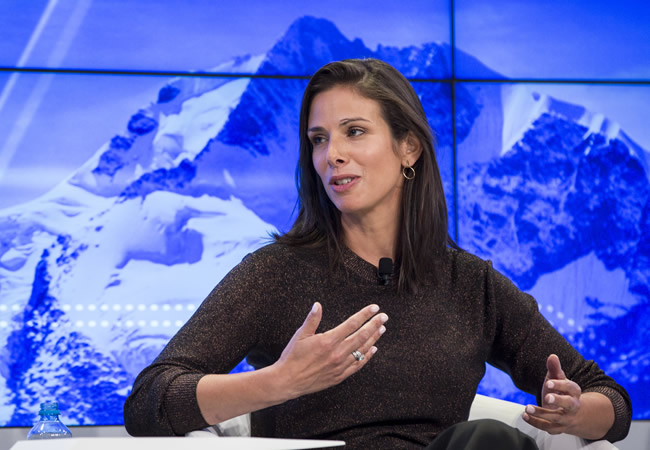
Photo: Rachel Botsman, Visiting Academic and Lecturer, Saïd Business School, University of Oxford, United Kingdom, speaking during the Session “In Technology We Trust?” at the Annual Meeting 2018 of the World Economic Forum in Davos, January 23, 2018. Image provided by & Copyright World Economic Forum / Faruk Pinjo.
Oxford, November 23, 2020 — The University of Oxford, in collaboration with AstraZeneca plc, today announced interim trial data from its Phase III trials that show its candidate coronavirus vaccine, ChAdOx1 nCoV-2019, is effective at preventing COVID-19 (SARS-CoV-2) and offers a high level of protection.
An early indication that the vaccine could reduce virus transmission from an observed reduction in asymptomatic infections.
There were no hospitalized or severe cases in anyone who received the vaccine. Extensive safety database from over 24,000 volunteers from clinical trials in the UK, Brazil, and South Africa, with follow up since April.
Crucially, the vaccine can be easily administered in existing healthcare systems, stored at ‘fridge temperature’ (2-8 °C), and distributed using existing logistics.
Large-scale manufacturing ongoing in over ten countries to support equitable global access.
Professor Andrew Pollard, Director of the Oxford Vaccine Group and Chief Investigator of the Oxford Vaccine Trial, said:
Professor Sarah Gilbert, Professor of Vaccinology at the University of Oxford, said:
Following the trial reaching the target for interim analysis, the independent Data and Safety Monitoring Board (DSMB) recommended that the Oxford team conduct its first analysis on all the cases with data locked on November 4, 2020.
Additional cases may accrue by the time of the final analysis, and future studies will determine the duration of protection. No severe safety events related to the vaccine have been identified.
Oxford will now support AstraZeneca in submitting both the interim Phase III efficacy data and the extensive safety data to all regulators globally, including in the UK, Europe, and Brazil, for independent scrutiny and product approval, and emergency use. Many of these regulators have been reviewing the trial data on a rolling basis during the trial.
In parallel, Oxford is submitting the full analysis of Phase III interim data for independent scientific peer review and publication.
The interim Phase III data builds on Oxford’s phase I/II peer-reviewed trial results, showing that the vaccine induces potent antibody and T cell immune responses across all age groups and has a good safety profile.
The clinical trials, enrolling over 24,000 participants from diverse racial and geographical groups in the UK, Brazil, and South Africa will continue to final analysis. Trial teams are conducting further tests in the United States, Kenya, Japan, and India. The trial unit expects to have 60,000 participants by the end of the year. These trials will provide regulators with further information about the Oxford candidate vaccine’s efficacy and safety, including its ability to protect against and stop the transmission of COVID-19.
The Oxford vaccine (ChAdOx1 nCoV-19) is made from a virus, a weakened version of a common cold virus (adenovirus), that has been genetically changed so that it can’t grow in humans.
Adenovirus vaccines have been researched and used extensively for decades and have a unique benefit: they are stable, easily manufactured, transported, and stored at domestic fridge temperature (2-8 degrees C). It means they can be easily distributed using existing medical facilities such as doctor’s surgeries and local pharmacies, allowing for the vaccine, if approved, to be deployed very rapidly.
Oxford University’s collaboration with AstraZeneca has been crucial to the successful development of the vaccine and vital for its global manufacturing and distribution across the world. AstraZeneca already has international agreements to supply three billion doses of the vaccine, with access being built through more than 30 supply agreements and partner networks.
A key element of Oxford’s partnership with AstraZeneca is the joint commitment to provide the vaccine on a not-for-profit basis for the duration of the pandemic across the world and in perpetuity to low and middle-income countries.
Professor Louise Richardson, Vice-Chancellor of the University of Oxford, said:
Source: The University of Oxford
|GlobalGiants.Com|
Oxford University’s ‘Vaccine for the World’ is Effective.
• Prime Minister Modi visits Serum Institute of India, Pune.
The Serum Institute of India is the manufacturing partner of the Oxford vaccine. The Pune-based firm has selected 17 sites in India, including PGI Chandigarh, to conduct the trial. A total of 1,600 candidates are taking part in the study.
Prime Minister Narendra Modi visited Serum Institute of India, Pune, on November 28, 2020, and interacted with the team at the Institute. In a tweet, the Prime Minister said, “Had a good interaction with the team at Serum Institute of India. They shared details about their progress so far on how they plan to ramp up vaccine manufacturing further. Also took a look at their manufacturing facility.”
Had a good interaction with the team at Serum Institute of India. They shared details about their progress so far on how they plan to further ramp up vaccine manufacturing. Also took a look at their manufacturing facility. pic.twitter.com/PvL22uq0nl
— Narendra Modi (@narendramodi) November 28, 2020
— The Editor holds an Oxford Alumni Card and is a Member of the Oxford and Cambridge Society of India.
Edited & Posted by the Editor | 8:40 AM | View the original post
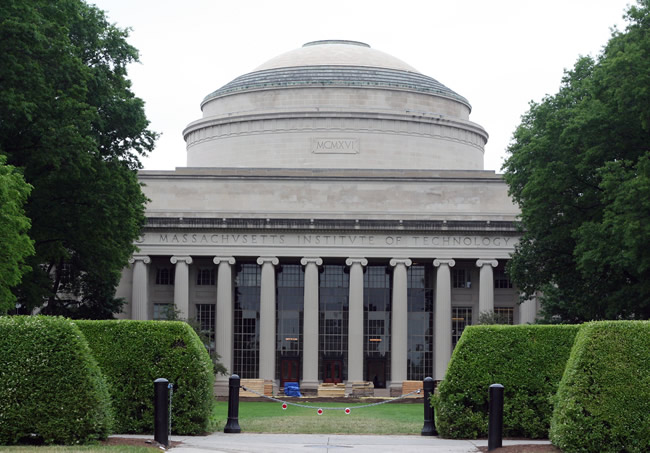
Photo: MIT. A building at the MIT campus. Image credit: Niall Kennedy.
London, November 3, 2020 — Times Higher Education today published the World University ‘Reputation’ Rankings 2020. These rankings reveal which universities have the strongest reputations among academics. For the first time, the list includes 200 universities, up from 100 in previous editions, making it the most comprehensive analysis Times Higher Education has undertaken on global university reputation.
Harvard University tops the ranking for the 10th consecutive year, and the US remains the most represented country, with 60 institutions.
The rest of the top 10 is the same as last year, except for one new entry in 10th place - the University of Tokyo. The Japanese institution rises one place to overtake the University of Chicago, which drops to 12th.
The UK still has the second-highest number of representatives in the ranking (25) and is led by the University of Cambridge at fourth.
Germany is now third in the country roll call, up from fifth last year, with 14 institutions, thanks to the table’s expansion. LMU Munich leads it in joint 42nd place. Australia, which is still the third most represented country in the top 100, drops down to joint ninth overall.
Elsewhere, ETH Zurich cements its place in the top 20, climbing three points to 17th, while National Taiwan University, the University of Manchester, and Sorbonne University rise to join the top 50.
Overall, universities in 30 nations are included in the ranking, up from 19 last year, Times Higher Education said.
Rank — University — Country
Source: Times Higher Education
|GlobalGiants.Com|
Edited & Posted by the Editor | 2:45 PM | View the original post
 |
 |
